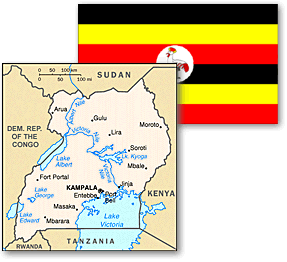Snapshot of Uganda
Location:
Uganda is bordered by five countries: the Democratic republic of the
Congo, to the
west; the Sudan to the north; Kenya, to the east; and Rwanda and
Tanzania, to the south.
To the southeast, Uganda has a coast on Lake Victoria, the largest lake
in Africa.
Land Area:
Uganda extends over 93,000 square miles, an area about the size of
Oregon.
Terrain:
70% of Uganda is covered by forests, woodlands, and grasslands. More
than 10% of the
territory of Uganda is protected in national parks, national forests and
game reserves.
Climate:
The weather in Uganda is quite varied. In the northeast section of the
country, the
climate is semi-arid and the average annual rainfall is less than 20
inches. In the
southwest, however, it can rain fifty inches or more in a year.
Population:
There are 19 million people living in Uganda. The people of Uganda are
ethnically
mixed. Most people belong to three main ethnic groups: Bantu, Nilotic,
and Nilo-Hamatic.
There are also many other ethnic groups represented in the population.
The population is
predominantly rural, and most people live in the southern sections of the
country.
Language:
The official language of Uganda is English, but many people also speak
the Luganda,
Swahili, Bantu, and Nilotic languages.
Religion:
Two-thirds of Ugandans are Christians, 16% are Muslim, and 18% follow
other faiths.
Major Cities:
The capital of Uganda is Kampala, which has a population of about
800,000. Other large
cities include Jinja, Mbale, and Mbarara
Government:
Uganda achieved independence from Britain on October 9, 1961. Every
year, Ugandans
celebrate October 9 as a national holiday. Uganda ratified a new
Constitution in 1995, and
held its first Presidential election a year later. As in our own
government, the
Constitution of Uganda specifies three branches of government: the
executive, the
legislative, and the judiciary. Currently, the Constitution restricts the
activities of
political parties, but in the year 2000 Uganda will hold a referendum to
determine if it
will become a multi-party democracy. The current President of Uganda is
Yoweri Kaguta
Museveni.
Economy:
Uganda’s economy has the potential for rapid development. The
country has
significant natural resources, fertile land, and regular rainfall. Most
of the industry in
Uganda is related to agriculture. The most important cash crop in Uganda
is coffee, which
accounts for 65% of the country’s exports.
Flag:
The flag of Uganda consists of six horizontal stripes--black, yellow,
red, black,
yellow, red. The national emblem, a crested crane, resides in a white
circle in the center
of the flag.

![]()


![[White House icon]](/New/images/home_pin.gif)
![[Help Desk icon]](/New/images/help_pin.gif)